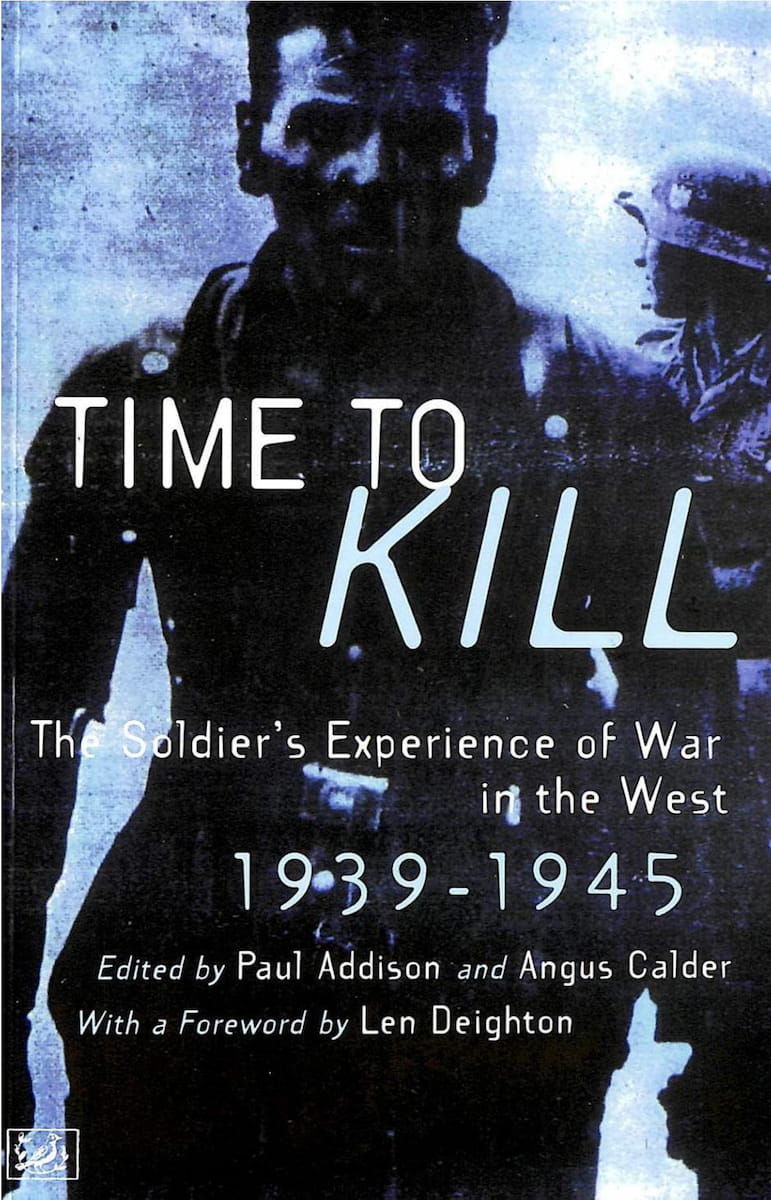
Ed. Paul Addison and Angus Calder
“Offensive Women,” in
Time to Kill:
The Soldier’s Experience of War in the West
1939-1945
Publisher: Pimlico Press
ISBN: 978-0712673761
Publication date: 1997
This is an exploration of the realities of soldiering across the ranks in World War II. A distinguished cast of historians have contributed, and look at the conditions in which the soldiers of many different countries lived and died, as well as at their hopes and fears and experience of battle.
CONTENTS:
Foreword / Len Deighton —
Preface / Paul Addison and Angus Calder —
Towards a theory of combat motivation / John Keegan —
Reflections on the ‘sharp end’ of war / John Ellis —
The Scottish soldier : reality and the armchair experience / Diana M. Henderson
The shadow of the Somme : the influence of the First World War on British soldiers’ perceptions and behaviour in the Second World War / G. D. Sheffield —
The British Field Force in France and Belgium, I939-40 / Brian Bond —
The real Dad’s Army : the British Home Guard, 1940-44 / S. P. MacKenzie —
The British soldier on the home front : army morale reports, 1940-45 / J. A. Craig
‘T̓was England bade our wild geese go’ : soldiers of Ireland in the Second World War / Ian S. Wood —
‘If I fight for them, maybe then I can go back to the village’ : African soldiers in the Mediterranean and European campaigns, 1939-45 / David Killingray —
‘Matters of honour’ : Indian troops in the North African and Italian theatres / Gerald Douds —
Mr Wu and the colonials : the British Empire’s evacuation from Crete, 1941 / Angus Calder —
‘If this war isn’t over, and pretty damn soon, there’ll be nobody left, in this old platoon…’ : First Canadian Army, February-March 1945 / Terry Copp —
‘No taste for the fight’? : French combat performance in 1940 and the politics of the fall of France / Martin S. Alexander —
The Italian soldier in combat, June 1943 : myths, realities and explanations / Brian R. Sullivan —
The Italian job : five armies in Italy, 1943-45 / Richard Holmes —
Peasant scapegoat to industrial slaughter : the Romanian soldier at the Siege of Odessa / Mark Axworthy —
Red Army battlefield performance, 1941-45 : the system and the soldier / John Erickson —
Offensive women: women in combat in the Red Army / Reina Pennington —
Motivation and indoctrination in the Wehrmacht, 1933-45 / Jürgen Förster —
The German soldier in occupied Russia / Theo J. Schulte —
Who fought and why? The assignment of American soldiers to combat / Theodore A. Wilson —
The GI in Europe and the American military tradition / Reid Mitchell —
‘Puir bluidy swaddies are weary’ : Sicily, 1943 infantry combat : a GI in France, 1944 / Hamish Henderson, Steve Weiss —
Trauma and absence : France and Germany, 1914-45 / Omer Bartov —
Oral history and British soldiers’ experience of battle in the Second World War / Nigel de Lee —
The soldier’s experience in two world wars : some historiographical comparisons / Hew Strachan.
from Reina Pennington’s essay on “Offensive Women: Women in Combat in the Red Army”
“If historians have failed to note the presence of military women in their study of history, it is at best the result of tunnel vision, and at worst, a case of deliberate oversight . . . In its use of large numbers of women in combat, the Soviet Union was unique in world history.
“By 1943, Soviet women had been integrated into all services and all military roles, ranging from traditional support roles like medical service, to primarily defensive work in anti-aircraft defense, to offensive combat roles in the infantry, artillery, and armor, as well as the partisan movement . . .
“Partisan Liudmila Kashichkina was captured when she was 23 years old. She says, ‘I was kicked and beaten with whips [until my skin was in ribbons]. I learned what a fascist ‘manicure’ is. Your hands are put on a table and a device of some kind pushes needles under your nails, all your nails at the same time. The pain is indescribable. You lose consciousness immediately . . . and there was some kind of machine. You heard your bones crunching and dislocating.’ Kashichkina was sent to a concentration camp in Germany, then transferred in 1944 to another camp in France. She escaped together with some French prisoners and joined the maquis. She was later awarded the Croix de Guerre and sent home to Russia.”
“
“In 1995 the History Department of the University of Edinburgh organised a conference titled ‘The Soldier’s Experience of War 1939-45’. A host of famous historians and researchers attended and this book is a collection of their presentations… The detail given on the various armies, their training, their strengths and weakness is often fascinating… Highly recommended!”
Amazon review
“
“So good, I bought it twice. This is wargeekery of the highest order. If you ever hear an armchair general spouting about how Italians or Romanians (or whoever) aren’t good at fighting, please smack him round the head with a copy of this book.”
Amazon review
“
“Reina Pennington provides one of the most interesting pieces of research in military history of recent years. She demonstrates that hundreds of thousands of
Soviet women served as front-line combatants on the eastern front, and brings their experiences (hitherto ignored both by women’s and military historians) into the light.”
